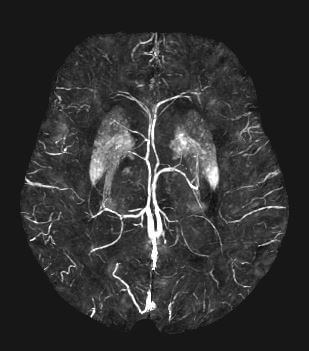
The Future of Quantitative Susceptibility Mapping (QSM) in Clinical Applications
By: Karen Holzberger, President & CEO of SpinTech MRI
The use of Quantitative Susceptibility Mapping (QSM) is often viewed as incompatible with current standard radiology workflows. Some radiologists or departments may be unaware of its existence or purpose. Despite the skepticism surrounding its viability in a clinical setting, QSM shows great potential in a wide range of clinical applications, particularly for biomarker detection and development.
Tissue Analysis & Biomarker Detection

QSM is an incredible tool for evaluating and quantifying neurovascular damage in high resolution because it allows for greater visualization of tissue differentiation—e.g. the appearance of calcium (which appears dark) or iron (which appears bright). And when compared to the outputs of a CT scan, QSM is more sensitive to visualizing blood products.
These attributes make QSM useful for biomarker detection for neurodegenerative diseases like stroke, traumatic brain injury, dementia, tumors, Parkinson’s, and multiple sclerosis. Outside of these biomarkers, it has also shown promise in evaluating the extent of tissue damage as well as quantifiably tracking the healing’s progress.
For example, a recently published paper used the STAGE™ version of QSM to noninvasively evaluate changes in asymmetrical oxygen saturation in acute ischemic stroke patients’ cortical veins. Researchers used QSM as a reliable method to longitudinally evaluate changing oxygen levels of the areas surrounding tissues damaged by reduced oxygen flow during the stroke as well as the brain’s capacity to regulate tissue oxygen levels in damaged areas.
Over the course of several weeks, the high-resolution scans helped researchers quantify the positive impacts of each patient’s treatment on their overall prognosis by clearly showing the difference in cortical vein oxygenation during each scan. There is evidence that QSM could allow clinicians to measure meaningful differences between people who react well to stroke treatments versus those who don’t while helping them determine how salvageable damaged tissue is.
An Issue of Workflow & Time
Despite its utility in quantifying neurodegenerative brain ailments, in many cases QSM is regarded as incompatible with clinical workflows.
QSM has two pitfalls to widespread clinical adoption:
1. The time it takes to generate an output.
2. The specialized knowledge needed to interpret the data.
Most clinical facilities don’t have the space or expertise within their radiology departments to collect and decipher the necessary data, and there historically haven’t been products available for easily integrating QSM into their internal workflow.
In most cases where QSM is used, the collected data must be sent to an external researcher—like an MR physicist—for adjustment and review. In some cases, the data may require hours of manual setting adjustment to produce a meaningful output. Oftentimes, the length and complexity of this process may make other protocols or means of collecting data more appealing.
Integrating into Workflows with STAGE
With SpinTech MRI’s STrategically Acquired Gradient Echo (STAGE) platform, the time and resource constraints usually associated with QSM protocols becomes significantly less limiting. Where a standard QSM scan may require time-intensive manual processing from a highly-specialized MR physicist, STAGE is a 10-minute scan that provides a general base for a wide range of protocols.
Instead of sending out data to an MR physicist for manual interpretation, STAGE collects the core data from the MR scan, which is automatically processed to generate QSM data. This provides significantly faster access to the scan’s quantitative data. While this data isn’t available instantaneously, it’s significantly quicker than the typical QSM process and fits smoothly into standard workflows.
In short, STAGE could bring the value and insight of QSM into previously nonviable research and clinical contexts, eliminating the need to outsource data manipulation and analysis. Eventually this may allow for easier QSM adoption in clinical settings by making its workflow integration more feasible.
A Comprehensive Approach to Treatment
From diagnosis to follow-up appointments, QSM has shown great promise as a useful tool in all aspects of patient care. With the application of STAGE making it more viable in a clinical setting, it isn’t unreasonable to think it could eventually provide clinicians with better data for disease diagnosis. It could even aid in pre-surgical or intervention planning, assist with therapeutic efficacy monitoring, help monitor disease status and progression, and serve as a useful tool during follow-ups or continued care.
SpinTech MRI’s QSM, iSWIM, has the potential for exciting applications in both research and clinical settings. In conjunction with the other 15 qualitative and quantitative outputs that our STAGE technology is capable of, these technologies can greatly help simplify workflows and improve patient experiences.
To learn more about STAGE’s other applications, visit our STAGE page. If you’re interested in learning more about how our technologies and services could benefit your radiological workflows, reach out to us.

